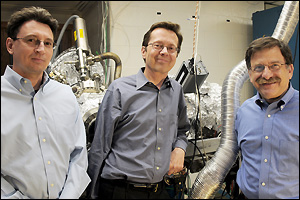
|
 |
Left to Right: Victor Galitski, Chris Lobb, and Gary Rubloff. |
|
Professor Gary Rubloff (Department of Materials Science and Engineering, Institute for Systems Research, and Maryland NanoCenter) is the co-PI on an interdisciplinary research collaboration with the Joint Quantum Institute (JQI) that has been awarded a five-year, $2.8 million grant from the Intelligence Advanced Research Projects Activity (IARPA) through the Army Research Office (ARO) to devise, fabricate, study and test a new kind of key component for quantum computing.
Rubloff's is joined on the project by JQI Fellows Victor Galitski and PI Chris Lobb (both from the Department of Physics); Kevin Osborn (Laboratory for Physical Sciences); and co-PI Charles Musgrave (Chemical and Biological Engineering, University of Colorado at Boulder).
The team will work on novel methods of constructing the crucial, ultra-thin insulating barrier that lies between two superconductors to form a "Josephson junction." A network of such junctions, employed as quantum bits, or "qubits," is an extremely promising candidate to serve as a basis for a quantum computer that could solve certain kinds of problems exponentially faster than today?s best supercomputers. But the microscopic sheets of aluminum oxide currently used in the junctions? insulating ("dielectric") barriers characteristically contain tiny defects, or regions with unfortunate atomic arrangements, that prevent the qubits from remaining for long in a quantum "superposition" of multiple states at the same time. That condition, called "coherence," is necessary during the computation time of the quantum computing algorithm.
"Under the best conditions, we can?t get coherence times longer than a few microseconds, and in most cases the times are much shorter," says Lobb, who has three decades of research experience with superconducting qubits, Josephson junctions and sub-micrometer electronics. "That?s much too brief for a working computer. It?s clear that the major problem is defects in the atomic configuration of the conventional barrier material. However, it may be possible to minimize structural defects in the junctions that are problematic?dramatically increasing the coherence time?by going beyond the conventional thermal oxide used by today?s qubit research groups. This proposal will allow us to carefully assemble the dielectric barriers one atomic layer at a time."
The team's assembly technique, called atomic layer deposition (ALD), uses alternating cycles of reactive gases to achieve nanoscale conformal dielectric films. ALD is widely employed by Intel and other microelectronics companies, but it has not been applied to Josephson junctions.
Rubloff, an expert in ultraclean processing and ALD nanostructures, will grow and perform surface analysis on both conventional oxide and the new ALD dielectric barriers in a system configured explicitly for this work.
"We don?t know how much better ALD dielectrics will perform, but we will be able to compare both junction types from our customized deposition and analysis system to find out," he says.
Osborn, who specializes in qubits and low-temperature measurements of dielectrics, will characterize the junctions at low temperature prior to incorporating them into qubits. The defects in the junctions can appear randomly, which leads to noise as well as poor coherence. "By attempting to improve superconducting qubits?we are [also] going to bring new understanding to universally-observed noise phenomena in superconducting devices," he explains.
Candidate defect structures and mechanisms will be studied by two theory groups. Musgrave will simulate candidate defects using his expertise in atomic modeling calculations of metal-insulator interfaces. He will also be able to use input from surface data taken by Rubloff during the junction growth. Galitski, an expert in superconductivity and defect models, will produce a comprehensive theoretical analysis of how defects affect junctions, and will work with Musgrave to identify which simulated defects are likely to lower the coherence at low temperatures.
"This kind of interdisciplinary synergy is exactly what the superconducting qubit community needs," Lobb says. "By bringing together proven expertise in both theory and experiment, and a wide variety of perspectives from physics, engineering and chemistry, we will be able to mount a uniquely powerful research effort."
Story courtesy of and adapted from the original published by the Joint Quantum Institute.
Learn more about the collaborators and their participating facilities:
Visit the Joint Quantum Institute web site »
Visit the Laboratory for Physical Sciences web site »
Visit the Maryland NanoCenter web site »
Visit Dr. Galitski's web site »
Visit Dr. Lobb's homepage »
Visit Dr. Musgrave's homepage »
Visit Dr. Osborn's web site »
Visit Dr. Rubloff's web site »
December 14, 2009
|

